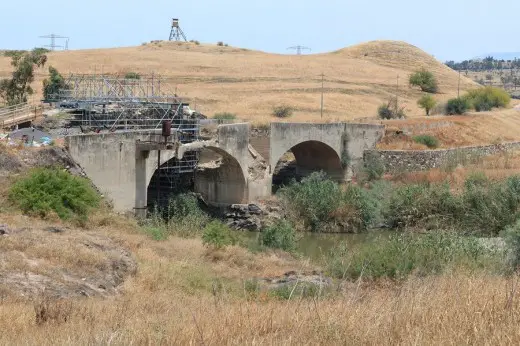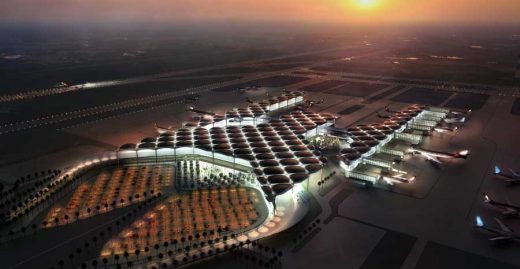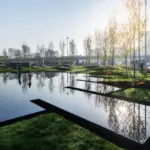Old Gesher Bridge Compound Israel, Architect, Image, Design, JRPP Project
Jordan River Peace Park
Israeli-Jordanian Jordan River Peace Park (JRPP), Middle East, by Yale Urban Design Workshop, USA
post updated 30 Jan 2020 ; 11 Jun 2014
Jordan River Peace Park – Israel / Jordan
Design: Yale School of Architecture’s Urban Design Workshop (YUDW), USA / Jerusalem’s Bezalel Academy of Arts and Design, Israel
Yale’s Urban Design Workshop building bridges to the first peace park in the Middle East
By Amy Athey McDonald June, 2014
Location: Old Gesher three-bridge compound in Israel, close to border with Jordan
Photos: A tour of the proposed Jordan River Peace Park
Aerial view of the Old Gesher bridge compound:

photo courtesy Friends of Earth Middle East
A team of architects from the Yale School of Architecture’s Urban Design Workshop (YUDW) and Jerusalem’s Bezalel Academy of Arts and Design is set to move forward on part of the proposed Israeli-Jordanian Jordan River Peace Park (JRPP), to be the first peace park in the Middle East.

Nearby is a 14th-century inn from the Mamluk period, which served as a place of rest for merchants and travelers crossing the river. The Turks later added a customs house.
photo courtesy Andrei Harwell
In particular, the team is looking to develop the Old Gesher bridge compound in Israel, a site dating back to the Roman Byzantine period, which would become the park’s southern gateway.

The Ottoman Empire railway bridge in the Old Gesher compound.
photo courtesy Andrei Harwell
Progress on the project was made following a three-day intensive workshop — or charette — held on site in May to develop detailed designs and recommendations for the park. Among the short-term projects planned are a small interpretive and visitor’s center, a Jordan River promenade, and a craft workshop.

Built in the Bauhaus style in the early 20th century, the remains of this train station sit on the former Ottoman-built Hejaz Railway. It serviced workers at the power plant and is the lowest train station in the world at more than 800 feet below sea level.
photo courtesy FoEME
The leaders of the May workshop — Alan Plattus ‘76, project leader at YUDW and professor of architecture and urbanism at the Yale School of Architecture (YSOA), and Andrei Harwell ’06 MArch, project manager at YUDW and critic at the YSOA — have been involved in the project since 2008, when they traveled to the site for a week-long charette. During that first trip they were joined by three faculty members and three graduate students from the School of Architecture, along with undergraduate filmmakers Sofy Solomon ’09 and Reid Wittman ’09, who filmed a documentary about the project.

Jordanian and Israeli flags on the steel Bailey bridge over the Yarmouk River mark the entrance to Peace Island.
photo courtesy EcoPeace/FoEME
“We’re very excited to be back on the ground in the area of the proposed Jordan River Peace Park to work with our colleagues from Friends of the Earth Middle East (FoEME) and Bezalel,” said Plattus. “We hope to be able to build on the good work that has already been done and look forward to seeing some of the exciting new developments come to life in the not-so-distant future.”

In May the team gathered again to develop detailed designs and recommendations for the park. Harwell (far left) and Plattus (front row, second from right) took the group to nearby Belvoir Castle — a Crusader fortress on a hill six miles south of the project site — which offered unparalleled views of the Jordan River Valley.
Crossing the Jordan River
The proposed park would cross the border between Israel and Jordan on the lower Jordan River. The area sits six miles south of the Sea of Galilee and would stretch from the Old Gesher compound in the south to the Yarmouk River in the north, and from Road 90 in Israel on the west to the villages of North Shunah and Bakoura in Jordan on the east.
Led by FoEME, the Jordan River Peace Park initiative has brought together designers, builders, economists, cultural and natural heritage experts, local government officials, and interested members of the public from Israel, Jordan, and Palestine. The goal is to have the nearly 2,000-acre site accessible to visitors from both sides of the river without the need for passports or visas, creating a safe space for people to meet and interact.
Three bridges dating from different eras would lead to the park. This one is from the Roman Byzantine period:

photo courtesy Pikiwikiisrael/ Wikimedia Commons
The Old Gesher compound, which was the focus of the most recent charette, contains three historic bridges that span the Jordan River, dating from the Roman Byzantine, Ottoman, and British periods. The compound also features a 14th-century inn from the Mamluk period, which served as a place of rest for merchants and travelers crossing the river.
In addition to the Old Gesher compound, the park would comprise the Peace Island — at the confluence of the Jordan and Yarmouk rivers — the abandoned Palestine Electric Company hydroelectric power plant, a British police station, an Ottoman customs house, and an historic train station and railway.

Three co-directors of Friends of the Earth Middle East (FoEME) at the Jordan River. From left to right: Gidon Bromberg (Israel), Munqeth Meyhar (Jordan), and Nader Al-Khateeb (Palestine).
photo courtesy FoEME
Plattus and his team are looking at the restoration and adaptation of structures throughout the park. Some would be returned to their original condition, while others would be used for a visitor’s center, or repurposed for eco-lodging and a conference center. (See below for details about each area.)

The proposed park sits along the Great Rift Valley, a major migration corridor from Africa to Asia. Some 500 million birds fly over the area twice every year, including Eurasian cranes (pictured here), Lesser Spotted Eagles, Levant Sparrowhawks, and Honey Buzzards.
photo courtesy Dudubot/Wikimedia Commons
“The most likely thing to move forward immediately is the customs house, which will be renovated into an interpretative and visitor’s center to introduce people to the idea of the peace park,” said Harwell.
Plattus added that successfully completing a smaller-scale project in the short-term, such as the visitor’s center, ultimately benefits the larger plan.
“The longer process is complicated and dependent on national-level politics,” he said. “But FoEME wants to show that there has been positive progress and that this has real economic development value, especially to the local governments and citizens.”

The former homes of workers who ran the power plant in the 1920s and 1930s would be renovated into overnight lodging for visitors. A conference center may also be built nearby in the park.
photo courtesy FoEME
Benefits of ecotourism
FoEME co-founder and director Gidon Bromberg, an environmental activist who was a Yale World Fellow in 2007, sees ecotourism and heritage tourism as an important source of economic development in an agricultural area that has 40% unemployment.
“One goal of the park is to diversify incomes, so the rural communities aren’t dependent on just farming, but have other sources of income that complement farming activities,” he said in the 2008 documentary. “Over time these may replace farming as the main source of income.”

The British Mandate bridge in the Old Gesher compound.
photo courtesy Andrei Harwell
Bromberg co-founded FoEME in 1994 with the goal of bringing together fellow environmental activists from Jordan, Israel, and Palestine. The idea of a peace park took root in 2006, with Yale getting involved after Bromberg and Plattus met during the former’s tenure as a World Fellow at Yale. Bromberg invited Plattus and Harwell to be part of the 2008 planning team to establish the conceptual framework for the peace park.
“What Gidon saw for the peace park and what we were doing in the Urban Design Workshop was spot-on,” said Plattus. “The idea of doing something like this on the other side of the world seemed challenging, but by applying the same methods that we use locally to get ourselves grounded in a community, we got imbedded there fairly quickly.” He noted that people in Israel and Jordan often cite his colleague, Andrei Harwell, as the world expert on the park site.

The turbine hall of the former hydroelectric power plant is the site of a proposed interpretive and visitor’s center.
photo courtesy Andrei Harwell
While initial work will take place on the Israeli side, planners are firmly committed to moving forward with both sides of the historic bridges in a parallel manner. Bromberg said FoEME studies reveal that only when the two areas are united into a single peace park will the full potential of the site be realized to what the Jordanians have labeled the “Petra of the north,” referring to the country’s most popular tourist attraction. Planners predict that the peace park could see as many as half a million annual visitors someday.
An area of immense historic significance, the proposed park also sits amid a major migration corridor along the Great Rift Valley, and some 500 million birds fly over the area twice every year. One proposed idea is to flood a now-dry lakebed and create a bird sanctuary.

Andrei Harwell (left) and Alan Plattus at the Yale Urban Design Workshop.
photo courtesy the Chapel West Special Services District
The Jordan River also provides ecotourism opportunities, though in recent history it has been overrun with sewage from the neighboring countries of Israel, Syria, and Jordan. The JRPP initiative will support efforts to rehabilitate the Jordan River, as well as its largest tributary, the Yarmouk River, which at one time supplied up to 40% of the region’s water but is now severely limited due to damming.
“The extensive area of the proposed Jordan River Peace Park offers a rich landscape to explore our region’s shared cultural and natural heritage,” said David Guggenheim, an architecture professor at Bezalel Academy. “At this time when peace negotiations have seemingly been put on hold, it’s more important than ever to build spaces and opportunities to meet and interact with our neighbors.”
Areas of interest in the Jordan River Peace Park
Peace Island

A map of the Peace Park.
photo courtesy Andrei Harwell
This area of land sits on the border of Israel and Jordan — at the heart of the planned peace park — where the Lower Jordan and Yarmouk rivers intersect. Following the Jordanian-Israeli Peace Treaty in 1994, the man-made island was granted a special status that allows visitors from both sides to access the area.
Visitor’s Center
Plans are underway to create an interpretive and visitor’s center in the former turbine building of the Palestine Electric Company’s hydroelectric power plant. Built in 1927, it supplied electricity to both sides of the Jordan River from 1932 to 1948. The abandoned structure will house a museum, exhibition space, and an environmental education center.
Train Station and Railway
Built in the Bauhaus style in the early 20th century, the station sits on the Haifa-to-De’era line of the former Ottoman-built Hejaz Railway. It serviced the hydroelectric power plant workers from 1920 to 1932 and is the lowest train station in the world at more than 800 feet below sea level. Plans are underway to renovate it to its former glory.
Old Gesher Compound
A historic crossing point over the Jordan River, the Old Gesher compound includes a Roman Byzantine bridge that was modified during the Crusades; an Ottoman Empire railway bridge, built to connect Haifa to Damascus, Mecca, and Medina; and a 20th-century British Mandate road bridge that allowed travel from Haifa to Baghdad. During the 14th century, the Mamluks added a khan — an inn for travelers — on the ancient road. The Turks also added a customs house and the British a police station, which will be renovated for use as a hotel for visitors.
Ecolodges
The former homes of workers who operated the power plant in the 1920s and 1930s will be renovated into overnight lodging for visitors. A conference center may also be built nearby in the park.
Entrance Gates
Four entrance gates will allow visitors access to the peace park — two from Israel and two from Jordan. Each gate is designed to highlight a unique aspect of the park’s ecology. The Wetland Gate is the north entrance from Israel via Naharyam; the River Gate is the southwest entrance from Israel via the Old Gesher compound; the Arid Sustainable Agriculture Gate is the northeast entrance from Jordan via Bakora; and the Arid Landscape Gate is the southeast entrance from Jordan via North Shunah.
Jordan River Peace Park images / information from Yale School of Architecture’s Urban Design Workshop (YUDW)
Jordan River Peace Park Partners
Yale School of Architecture, USA
Bezalel Academy of Arts and Design, Jerusalem
Israeli-Jordanian Jordan River Peace Park
Urban Design Workshop (YUDW)
Location: Old Gesher, Israel / Jordan, Middle East, Weastern Asia
Jordan Architecture Designs
Contemporary Jordan Architectural Selection
Jordanian Architecture Design – chronological list
Queen Alia International Airport, Amman
Design: Foster + Partners

picture © Foster + Partners
Queen Alia International Airport
‘Living Wall’ project, Amman, northern Jordan
Design: Foster + Partners

picture © Foster + Partners
Amman Building
Petra Visitors’ Centre, Arabah, Ma’an Governorate, southern Jordan
Design: Edward Cullinan Architects
Jordanian Building at Petra
Comments / photos for the Jordan River Peace Park page welcome





